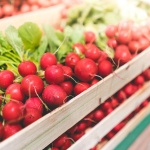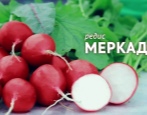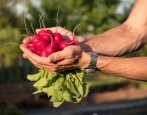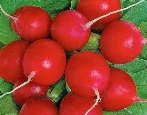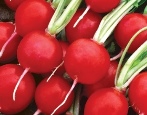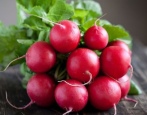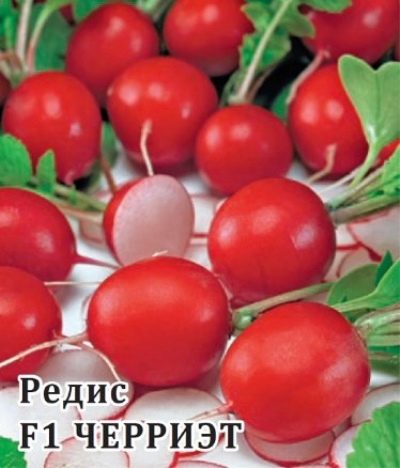
- Name synonyms: Cherriette
- Year of approval: 2007
- Ripening terms: mid-late
- Leaf rosette shape: semi-upright
- Leaves: narrowly ovoid, grayish green
- Petiole: with strong anthocyanin coloration
- The form: rounded
- Coloration: red
- Weight, g: 25-30
- Color of the pulp: white
Cherriet variety is able to show everyone what an ideal radish should be. This variety has absorbed some advantages and is practically devoid of disadvantages.
Description of the variety
Cherriette radish is a native of Japan, entered into the Russian State Register in 2007. This variety quickly became popular for its perfect juicy heads without a pungent taste and excellent technical characteristics. Radish, with which it is impossible to go wrong.
Characteristics of the appearance of the plant and root crops
The rosette is compact, up to 25-30 cm high, slightly spreading. Leaves are oval, on bright red petioles 5-7 cm long. The shade of the leaves is delicate - green with an ash tint. Arrows in the plantings of the variety can be seen very rarely.
The shape of the root crop is close to a perfect ball. Average weight - 25-30 grams. The diameter of the fruit can range from 3 to 6 cm, depending on the growing conditions. The caliber is good, the fruits are aligned, look great in bundles. The skin is red, the tail is short, red with a white tip. The pulp is snow-white, amazingly smooth, firm and juicy. Not prone to oakiness, the formation of veins, voids, flabbiness. Keeping quality is excellent - the fruits are stored in the refrigerator for up to 4 weeks.
Purpose and taste of tubers
The taste is excellent, the radish is medium-sharp. The taste is both spicy and delicate. The consistency emphasizes the freshness of the pulp - juicy, even. Designed for fresh consumption and sale.
Maturation
The hybrid is mid-late. The fruits ripen one month after the emergence of mass shoots.
Yield
The yield is excellent, the average indicators are 2.4-2.7 kg per 1 sq. m. On high agricultural technology, they collect 3 kg per 1 sq. m. m.
Growing regions
Radish Cherriet, despite its overseas origin, is hardy. It can be grown in all regions of Russia, from the North Caucasus to Siberia and the Far East.
Growing and care
The variety is intended for cultivation in private household plots. Radishes are quite picky about sunlight, so it is better to choose the lightest and most open areas for planting. In the shade, the plant will "go to the tops", the gardener will receive lush "tops" and small "roots".
The length of daylight hours does not matter. The Cherriet hybrid is suitable for growing even in the summer - it does not shoot, the fruits will be poured and juicy.
It is advisable to calibrate the seeds by size, soak them in warm water for a day, then warm them up in hot water (+ 50 ° С) for 20 minutes. Drain the water, dry the seeds. Cherryet seeds do not need to be soaked in stimulants, this is usually done by the manufacturer, but you can do it yourself: the seeds are placed in Epin solution for 12 hours. After that, the seeds are again dried in the fresh air, and immediately sown in the ground.
Sowing time - from early March to early April. Depends on the region. In the middle lane, the standard sowing date is the first decade of April. Cherriet is suitable for sowing during the entire warm season, in this case, a suitable area is sown with seeds once every three weeks.
The hybrid is sown according to the scheme: 5-7 cm between plants, 15 cm between rows. Sowing can be carried out alternately if it is planned to get a crop on the same bed throughout the summer. The seeding depth is 1 cm.
When shoots appear, it is important to provide the plant with regular watering. The ground should be well wet by 10 cm and not dry out. The culture is growing rapidly, so moisture is needed urgently.Unstable watering will not impair the palatability of this variety, but will cause the fruit to crack. With an acute lack of moisture, the pulp will become dry, tough and burning, the fruits are greatly crushed. The optimal frequency of watering is 2 times a day, in the morning and in the evening. Drip irrigation works best. And it will also be very useful to mulch the soil with sawdust, grass, straw.
The second mandatory moment of care is weed removal. These are competitors.
Fertilizers are usually not needed, even the late varieties of radish have a very short growing season.
Cherriet does not cause problems for the gardener, but some difficulties are possible if the conditions are violated. In a too hot summer, even he is able to start giving arrows. Excessive nitrogen or the presence of fresh manure in the soil will result in poor taste. The radish grinds if watering is excessively abundant or insufficient, if the seeds are too thick or deeply planted. Poor soil structuring will have a bad effect on the size of root crops. The soil must be breathable.
The plant can be affected by powdery mildew and cruciferous pests. Compliance with the distance between plants, following the rules of crop rotation and treatment with "Fitosporin", which can be used for irrigation, will help.
Radish Cherriet is medium late, so it has excellent keeping quality. The fruits remain fresh in the refrigerator for several weeks without additional tweaks. However, you can help him: the radish, along with the tops, is placed in a bag or container. Pour cool water into the container. The tops are periodically sprayed. Such radish will be fresh and fragrant even longer.
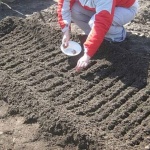

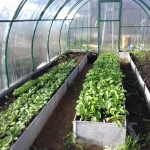
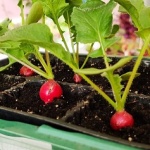
Soil requirements
The soil should be light, airy, rich in organic matter. In doing so, it is important to avoid extremes. Heavy clayey soils and poor sandstone will not work. When preparing the soil, the site is well fertilized with rotted compost. Fresh manure is not allowed.
It is better to prepare the soil in the fall, then in the spring sowing can be done immediately after the snow melts. Any roots are carefully removed from the soil, this partially solves the issue of weeds.
One of the soil preparation schemes: for 1 sq. m sand - 0.5 buckets, humus - 0.5 buckets, dolomite flour - 0.5 liters, ammonium nitrate - 1 tbsp. l., superphosphate - 40 g, potassium chloride - 15-20 g.
The acidity should be medium - pH 6.2-6.8. Radish grows poorly on too alkaline or too acidic soils.
Radishes are not planted after cruciferous plants: horseradish, watercress, cabbage. The best predecessors are potatoes and greens. You should not sow a crop next to onions, cucumbers, beets. Good neighbors: carrots, cabbage, tomatoes, beans.
Required climatic conditions
Radish can withstand short-term temperature drops down to –3 ° С, adult plants tolerate frosts down to –6 ° С. But the optimal range for growing crops is from + 12 ° C to + 16 ° C.

Review overview
Reviews confirm: the variety is excellent. The yield may be less than stated, but it is still impressive. Fruits are pot-bellied, numerous, with strong uniform pulp. Such a result will be with good watering. If desired, the radish can be harvested earlier, on the 18-20th day, it will be small, up to 2 cm, instead of 4-5 cm, but these are still fresh vitamins to the table. In general, the variety, as promised, is medium late - ripens in the prescribed 30 days. The taste is spicy, but not pungent, suitable even for children's dishes. The rosette of the variety is really small.
I like the variety for its large size - it stands out strongly against the background of other varieties. It is appreciated for the magnificent appearance of the fruits - they are all the same, even and beautiful. And also flawless pulp is often noted in it - it is smooth, tender and juicy. Japanese cherry radish is good in all respects, the variety can be safely recommended to everyone.
